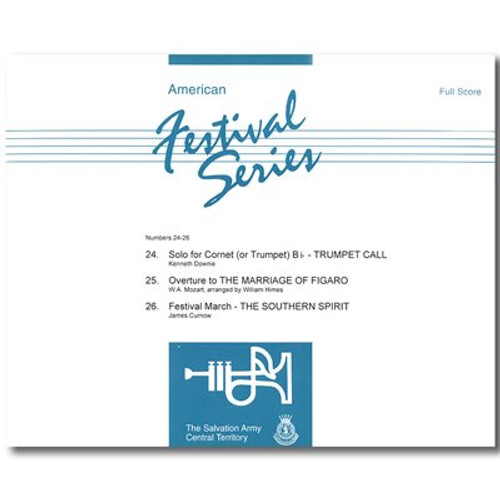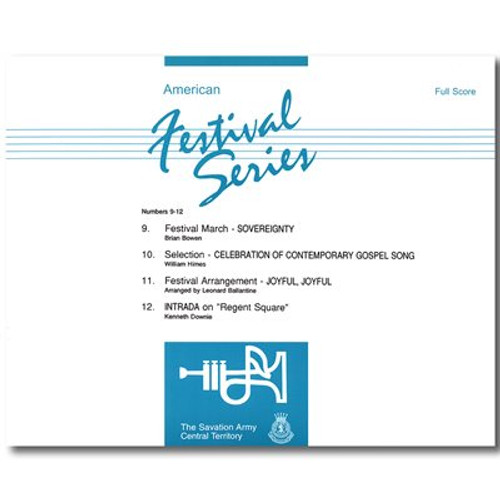Product Description
June 1987 - Nos. 1-4
Comments by Staff Bandmaster William Himes
Music Secretary, USA Central Territory
Introduction
The Salvation Army Central Territory is proud to inaugurate its first publication of the American Festival Series after virtually years of preparation, editing and just plain hard work. Grateful acknowledgement is expressed to Commissioner Robert Rightmire and the entire USA Commissioners' Conference for making this band journal possible.
To be accurate, the American Festival Series was first published in 1928, with the then Ensign William Broughtton serving as editor. Unfortunately, this publication folded after producing just ten items through 1930.
The intervening years have seen remarkable strides being made in the quality and standard of Army brass bands in North America. This growing tradition, coupled with the unmistakable influence of the American concert band movement, has produced a wealth of composers willing to give of their creative talents to Salvation Army music. With this in mind, it is hoped that this new version of an older idea will be a means of providing music that will be useful and challenging to Salvation Army bands, while being a source of blessing and inspiration to those who listen.
| 1. | Festival March - Able | William Turkington, rescored by William Himes | Notes |
| 2. | Cornet Solo - I'd Rather Have Jesus | arr. William Himes | Notes |
| 3. | Gowans and Larsson Overture | William Broughton | Notes |
| 4. | Post Bellum Rhapsody | Erik Leidzen | Notes |
sample music for "I'd Rather Have Jesus"
sample music for "Post Bellum Rhapsody"
(view series guide)
Produced by The Salvation Army - Central Territory
1. Festival March - Abel
Program Note:
Although written by a sixteen year-old more than thirty years ago, this march has never lost its dazzle and energy as it features the well-known hymn, "'Are ye able,' said the Master."
Although written by a sixteen year-old more than thirty years ago, this march has never lost its dazzle and energy as it features the well-known hymn, "'Are ye able,' said the Master."
Note to the Conductor:
As in all marches, this exciting work will come to life if attention is especially given to accents and dynamic contrast. Specific concerns are as follows:
Intro: Careful drill and instruction are needed to achieve precision with the unusual opening triplet rhythms. (You would be advised to slightly "cheat" the tie between beats 1 and 2 to avoid having the tempo bog down.)
Meas. 3: Note that the dynamic suddenly recedes to f before beginning the second crescendo.
Meas. 7-10: Aside from the technical concerns in the cornet parts, give good attention to the accented chords of the horns, baritones, euphoniums and basses. Balance and precision are the objectives here.
Meas. 14: The entry of the soprano, 1-2 cornets and 1-2 trombones must be precise and cleanly tongued.
Meas. 27-30: Exaggerate the softness of this section. The conductor must give a clear and confident cue to the solo cornets in meas. 28 and 30 to assure a good ensemble entry.
Meas. 32: While the entire band reaches a ff peak at this measure, care must be given to bring out hte important movement of the soprano, 1st cornet and flugel.
Meas. 36-59: From the horn section pick-up to this measure, the style (legato) and dynamics (p) must be of startling contrast. However, the conductor will also need to seek for melodic clarity, making sure that repeated pitches are tongued cleanly (especially meas. 39, 44-45, 52-53, etc.)
Meas. 60-67: Accents must be achieved by "lifting" the tonguing intensity and air pressure one level higher - while making certain that the other non-accented notes are lighter than usual for maximum contrast.
Meas. 67-68: Don't be afraid to pull back the tempo on beats 2-4 to savor the rich sonorities of these modulating chords, being careful to immediately return to the a tempo in meas. 68. Regardless of the exciting effect at this point, the dynamics must drop quickly to get down to mp by beat 3.
Meas. 77-end: The conclusion should be a brilliant fanfare with a firm marcato style being employed in all sections.
2. Cornet Solo - I'd Rather Have Jesus
Program Note:
This was originally written for Mr. William Scarlett, former Chicago Staff bandsman and presently a member of the trumpet section of the Chicago Symphony Orchestra. This gospel melody was a particular source of inspiration and strength to Mr. Scarlett during a time of personal crisis when dental complications threatened the end of his playing career. The second verse speaks especially to this point:
This was originally written for Mr. William Scarlett, former Chicago Staff bandsman and presently a member of the trumpet section of the Chicago Symphony Orchestra. This gospel melody was a particular source of inspiration and strength to Mr. Scarlett during a time of personal crisis when dental complications threatened the end of his playing career. The second verse speaks especially to this point:
- "I'd rather have Jesus than men's applause,
- I'd rather be faithful to His dear cause;
- I'd rather have Jesus than world-wide fame,
- I'd rather be true to His holy name."
Note to the Conductor:
This transparent accompaniment should pose no technical challenges. A few cautions should be noted, however:
Intro: The conductor should let the soloist begin without the visual distraction of beating time. Begin conducting the band with the pick-up to meas. 9.
Meas. 17-24: Strive for a rich symphonic sonority, allowing the euphonium and horn to blend and project the illusion of a french horn timbre.
Meas. 50-55: Be certain to move the tempo ahead slightly to accommodate the long phrases of the soloist. To achieve this the conductor will need to make sure the 1st and 2nd trombone entries do not drag.
Meas. 58-59: Work to make the climax convincing - with intense sonority and a steep diminuendo leading into a tranquil finish.
Meas. 64-end: The accompaniment entry must be gentle, but precise. Don't be afraid to subdivide the beats of the final measure.
3. Gowans and Larsson Overture
Program Note:
With true Hollywood style, this talented West Coast arranger has created a delightful potpourri of melodies from Army musicals from the team of John Gowans and John Larsson.
With true Hollywood style, this talented West Coast arranger has created a delightful potpourri of melodies from Army musicals from the team of John Gowans and John Larsson.
Note to the Conductor:
This vivacious overture is certain to be a popular addition to our brass band literature. Abounding with idiomatic diversity and harmonic variety, this work should prove to be a good challenge as well. When preparing this piece, keep the following in mind:
Intro: The skill of double-tonging will be a necessity to capture the excitement and pace of the opening. WHen working on this section, emphasize that the rhythm pattern is repeated every two measures.
Meas. 8-13: Coordinate the rhythmic patterns of the euphonium and Eb-Bb basses into one pulsating, composite ostinato.
Meas. 22-31: This being in swing style, the trombones should be less literal in their execution of the dotted-eighth and sixteenth rhythms. This idiom calls for more of a "6/8 feel" to be convincing.
Meas. 32-46: The snare drum is a vital factor in keeping the forward motion of this tempo. Nevertheless, the overall band timbre should be mellow here.
Meas. 55: Note the fp crescendo comes back to just mf.
Meas. 70-73: Give attention to the detailed articulations the composer has provided for the euphoniums and baritones, as well as the answering trombones.
Meas. 74: Syncopated "shot notes" will likely need rehearsal "in four" to build confidence before bringing the tempo up to the given "alla breve." Strive for attacks that are firm and detached.
Meas. 103-106: Make the most of the exaggerated tempo changes.
Meas. 114-121: The solo cornets provide a florid descant which is reinforced in bits and pieces by the 1-2 cornets, flugel and horns. Synchronization is the objective! (The same holds for the euphoniums/baritones at meas. 122-133.)
Meas. 174-end: The sting of the ffp should make it possible for these parts to get out of the way, postponing the returning crescendo until the rising chromatic scale is well established.
4. Post Bellum Rhapsody
Program Note:
The American Civil War has been called the "singingest war in history," with much of its music remaining a part of our national life. Erik Leidzen has created a climatic kaleidoscope suggestive of the hope, determination and courage of a nation at the downing of a new era - strong and united.
The American Civil War has been called the "singingest war in history," with much of its music remaining a part of our national life. Erik Leidzen has created a climatic kaleidoscope suggestive of the hope, determination and courage of a nation at the downing of a new era - strong and united.
Note to the Conductor:
We are grateful to the owners of mills music for granting permission to reprint this "Leidzen classic" in brass band form. This edition is quite faithful to the composer's original brass band orchestration. However, because it originally included an independent (and soloistic!) re-piano cornet part, re-scoring was necessary. In the process care was taken to add essential cues, etc.
Throughout this rhapsody, the cornets and trombones will need to carefully work out the many mute changes that come up - and often very quickly. Beyond that, the conductor's specific concerns should include the following:
Meas. 31-32: The accelerando should be carefully controlled to provide a gradual transition into the 12/8 section at meas. 33.
Meas. 47-53: Give special attention and weight to the accents found in the baritones, bass trombones, euphonium, basses and percussion. (The bass drum can be especially valuable in this role.)
Meas. 55-56: An effective diminuendo here will make the f pick-up to 57 all the more surprising and effective.
Meas. 63-66: The dynamic effect should be as waves, with each sf crescendo beginning at hte same volume level.
Meas. 67-70: Strive for a balanced rise and fall of sound to encompass these four measures. (A convincing diminuendo can be a challenge for even the most experienced ensemble.)
Meas. 87: The conductor can anticipate this suddenly slower tempo by remembering the pace of the introduction.
Meas. 104-105: First and second cornets must strive for intensity in this muted passage. Intonation will also be a concern - especially for the second cornets (mutes will make low D and C# even sharper than usual.)
Meas. 111-178: In effect, this is one long and very controlled crescendo - achieved mainly by adding instruments rather than playing louder. The tempo should be rigidly adhered to, regardless of dynamic changes.
Meas. 147: Trombones must exaggerate the falling glissando to achieve the desired effect.
Meas. 210-end: Make the most of the final progression, reserving the fullest, most glorious sonorities for the final chord.









